To get some music, I added the Jordan's Flagon (with a cap for simple 1st order HP) to fill the upper half of spectrum, while the woofers were unfiltered, playing all they can. Turned it up, I had the following observations:
* Very dynamic and lively sounding from mid to bass. Unfortunately the Jordan on top is not a good match. It seems they are in different scale of dynamics. Mid to mid-bass hits hard, while the HF can't keep up. So the balance is not right at the moment. I need more time in overall tuning. (And, eventually I'll use other unit with higher efficiency, also in dipole for consistent directivity from low to high)
* Some resonances get more pronounced when playing loud. All panels seem very calm by touch, so I suppose the problems would be mostly in the cavity between drivers and wings. Will try more damping material. Seems there'll be many things to do on this ...
* Unexpectedly, there's little higher frequency in the sound escaped from the narrow part of aperture. It's mostly bass here. Higher range sound is radiated from the lower driver with less blockage. Should I put it upside down? But then the driver on top will be facing down. Hmmm....
Later I added PLLXO with additional amp for HF unit, but something went wrong. (almost certainly in such a hurry) I got hum and other problems to fix. Again, it's too late to do all these, had to sleep.
* Very dynamic and lively sounding from mid to bass. Unfortunately the Jordan on top is not a good match. It seems they are in different scale of dynamics. Mid to mid-bass hits hard, while the HF can't keep up. So the balance is not right at the moment. I need more time in overall tuning. (And, eventually I'll use other unit with higher efficiency, also in dipole for consistent directivity from low to high)
* Some resonances get more pronounced when playing loud. All panels seem very calm by touch, so I suppose the problems would be mostly in the cavity between drivers and wings. Will try more damping material. Seems there'll be many things to do on this ...
* Unexpectedly, there's little higher frequency in the sound escaped from the narrow part of aperture. It's mostly bass here. Higher range sound is radiated from the lower driver with less blockage. Should I put it upside down? But then the driver on top will be facing down. Hmmm....
Later I added PLLXO with additional amp for HF unit, but something went wrong. (almost certainly in such a hurry) I got hum and other problems to fix. Again, it's too late to do all these, had to sleep.
Unexpectedly, there's little higher frequency in the sound escaped from the narrow part of aperture. It's mostly bass here. Higher range sound is radiated from the lower driver with less blockage. Should I put it upside down? But then the driver on top will be facing down. Hmmm....
I had the same observation which is why I actually ended the aperture before it went all the way to the top driver. This let me add fiberglass stuffing in the upper chamber.
I concur here - some of the most lively and dynamic bass and mids I have heard.Very dynamic and lively sounding from mid to bass.
CLS,
Is there a reason you don't go with active DSP and multi-amp (a la miniDSP)? If not for debugging and fine tuning your XO's prior to making a proper PLLXO etc. Seems like you would really be able to eek out the last bit of performance and "what if" scenarios very quickly.
Thanks for the update and looking forward to more.
In my simulations, I always use the curvature of the K-aperture as specified by the K-15 plans, which I have converted to a quadratic non-dimensional curve fit as described here http://www.diyaudio.com/forums/full-range/213594-karlson-10.html#post3528706. However, in practice, the curves are often drawn by hand and what is important is the gap of the narrow portion of the slot and how high up it goes, and whether or not it goes to a cusp or a slot. So the narrow portion controls the bass extension. The remaining 70% where the wider portion is, is less critical but does affect the mids and HF output and possible coloration.
the first section and overall flare are useful for tuning system damping, response, tone - I think its cavity shape/size dependent plus dependent upon the midrange ability of the driver. Carl Neuser, who doesn't share data, nor use regular frequency analysis, tests 3-4 sets of wings per enclosure - he also is a believer in using a curved reflector per patent 3540544.
from what little testing I've done, its sometimes difficult for the microphone/analyzer combo to "see" a difference in response as the gap varies which subjectively sounds quite different - in that case think its the large and complex overall sound source whose picture isn't adequately described. Then on one tall aspect K enclosure, I could see a large difference as the response as the aperture went from full height to around 2/3 height,
sometimes the "air" disappears if a slot is too tight at the top - a narrowing slit may be useful. In old style K's which sound "too resonant in the bass, de-Q-ing holes or the distribute slot vent may be useful - but those will distort with pure sine signals.
it would be interesting if someone, sometime can investigate in 3D, their behavior - is a bandpass model and some guessing good enough for making a regular K? - why did GregB's Karlsonator seem to scale so well overall?
3rd K12 (full width rear shelf)
Karlsonator 8 prototype with vent set like a regular Karlsonette K12
HAK8/6.5
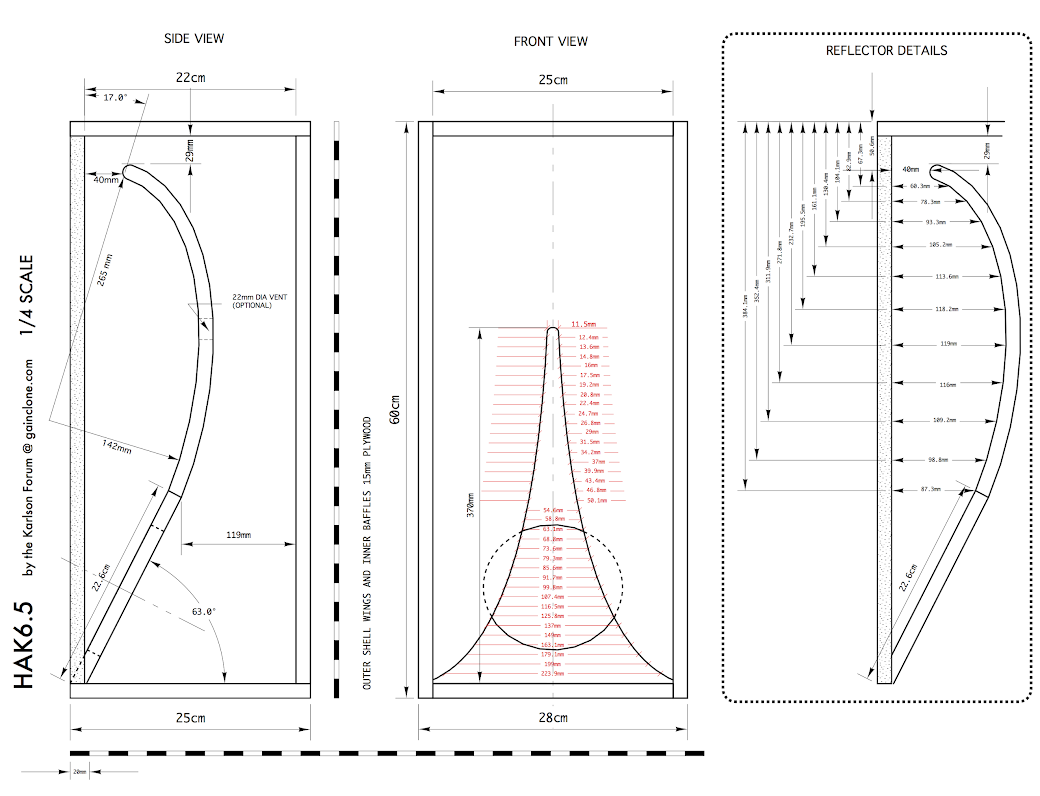
Karlsonator

from what little testing I've done, its sometimes difficult for the microphone/analyzer combo to "see" a difference in response as the gap varies which subjectively sounds quite different - in that case think its the large and complex overall sound source whose picture isn't adequately described. Then on one tall aspect K enclosure, I could see a large difference as the response as the aperture went from full height to around 2/3 height,
sometimes the "air" disappears if a slot is too tight at the top - a narrowing slit may be useful. In old style K's which sound "too resonant in the bass, de-Q-ing holes or the distribute slot vent may be useful - but those will distort with pure sine signals.
it would be interesting if someone, sometime can investigate in 3D, their behavior - is a bandpass model and some guessing good enough for making a regular K? - why did GregB's Karlsonator seem to scale so well overall?
3rd K12 (full width rear shelf)
An externally hosted image should be here but it was not working when we last tested it.
Karlsonator 8 prototype with vent set like a regular Karlsonette K12
An externally hosted image should be here but it was not working when we last tested it.
HAK8/6.5
Karlsonator

That's super cool CLS. It looks great to me, and you should win an award for most ambitious apartment build.  I know how hard this can be...
I know how hard this can be...
RE dynamics: I suspect that this is one case where you would want a large (8 inch?) efficient full range to keep up with the bass dipole modules, but it depends.
Level matching with an active crossover and biamping doesn't always make drivers of different efficiencies work together seamlessly, though obviously it helps.
RE dynamics: I suspect that this is one case where you would want a large (8 inch?) efficient full range to keep up with the bass dipole modules, but it depends.
Level matching with an active crossover and biamping doesn't always make drivers of different efficiencies work together seamlessly, though obviously it helps.
CLS,
We are all hanging onto the edge of our seats here for the verdict with the sound. Do you have a measurement mic and REW software? I have a hard time reading the little RTA screen you have. I think your bracing triangles make a huge difference. I could really feel the wings move on mine and that is the source of distortion.
We are all hanging onto the edge of our seats here for the verdict with the sound. Do you have a measurement mic and REW software? I have a hard time reading the little RTA screen you have. I think your bracing triangles make a huge difference. I could really feel the wings move on mine and that is the source of distortion.
I'm in the excited and kurious crowd too!
btw, 3/8" allthread and closet poles are good for regular K - K15 is easy with 3/4" dowel rod from the front shelf edge
btw, 3/8" allthread and closet poles are good for regular K - K15 is easy with 3/4" dowel rod from the front shelf edge
An externally hosted image should be here but it was not working when we last tested it.
An externally hosted image should be here but it was not working when we last tested it.
Thanks Greg 
Relax, X, hehe...
In the early stage of the project, I did it casually. Then, when it approached the finish line, I began to stand on the pedals and work hard. Now, maybe it's at about 90% of completeness, not sure, but I feel so tired and have to slow down a bit.
For previous question: yes I've considered DSP etc on and off all these years. I briefly tried DCX2496 several years ago when I had experience of multi-amp system for some time already. To use it or not seems nearly a philosophic question. Yes it's convenient and fast, but after all, I don't really need it.
There're so many factors in the whole system. Compared with other things, problems in XO (including EQ) are not bothering me too much. It's good to have it of course, but I still have to spend time and effort in fixing other problems. (And, as you see, I build things slowly anyway.) So, in general, I can live without the advanced digital gears. (DRC seems to has very high potential, I'll look into it later... )
Now, PLLXO is good enough for me. Last night I managed to fix it (in my pre-amp) to an extent, by which I got a proper rolloff. On paper (screen), it seems good beyond 1kHz, but actually it's pretty much breakup modes of the big cone above several hundreds.
It's 6dB/oct slope in the PLLXO, but as you can expect the actual (acoustic) rolloff is shallower and very irregular overall. The HP on Jordan is also 1st order, so a lot of overlap between them. I can't tell where the real XO point is. It's between 500-1.5k anyway, haha. Doesn't matter.
(I have a Behringer ECM8000, but it needs 37V phantom power. So I can't plug it in PC directly. I've thought of making one, but this is submerged by other things...)
By the (slightly) improved XO and the cleaner midrange, it sounded better overall last night.
But the innocent Jordan still falls behind, so the initial attack is somewhat rounded at this stage.
Not sure if it's proper to call it "bandpass effect" - a sense of popping air as it being squeezed through a small area. Or maybe it's brought by the resonances of midbass? Interestingly it's still there when the broad bump is suppressed by EQ. This makes the sound of mid to bass hit hard, very forceful as mentioned.
The area of aperture is about 52% of total Sd by calculation -- I make them several sections of trapezoids and sum. This could be somewhat small (for a Karlson). In my previous slot-loaded dipole, the area of slot is 40% Sd. That only loads one side of driver. Now it's 52% but on both sides, so the compression is more severe than before.
Maybe it's the reason I feel the pops, or, it comes together with some effect of resonances.
The alternative solution of HF section is an old Focal midrange -- Audiom 7K, which I own for decades. It's rated 98dB/w and pretty wide range. To mount it properly, I have to cut some wood. To add damping material in the wings, I have to remove them (8 in total). These are works for weekend. So, I guess this is it, for now.
About the damping behind the wings, I thought of expanding PU foam, which can make the shape of that space smoother. I think it's beneficial to midrange. It's like the passages in phase plug must be smooth. However, I also doubt if I need that much midrange from it. So I'll try damping (absorbing) first, which is also easier.
If the coming Focal can't deliver matchable upper half, maybe I'll try to cut the wings and make the apertures larger to ease of the compression. I hope I don't need to go that far. There're 8 of them!
Relax, X, hehe...
In the early stage of the project, I did it casually. Then, when it approached the finish line, I began to stand on the pedals and work hard. Now, maybe it's at about 90% of completeness, not sure, but I feel so tired and have to slow down a bit.
For previous question: yes I've considered DSP etc on and off all these years. I briefly tried DCX2496 several years ago when I had experience of multi-amp system for some time already. To use it or not seems nearly a philosophic question. Yes it's convenient and fast, but after all, I don't really need it.
There're so many factors in the whole system. Compared with other things, problems in XO (including EQ) are not bothering me too much. It's good to have it of course, but I still have to spend time and effort in fixing other problems. (And, as you see, I build things slowly anyway.) So, in general, I can live without the advanced digital gears. (DRC seems to has very high potential, I'll look into it later... )
Now, PLLXO is good enough for me. Last night I managed to fix it (in my pre-amp) to an extent, by which I got a proper rolloff. On paper (screen), it seems good beyond 1kHz, but actually it's pretty much breakup modes of the big cone above several hundreds.
It's 6dB/oct slope in the PLLXO, but as you can expect the actual (acoustic) rolloff is shallower and very irregular overall. The HP on Jordan is also 1st order, so a lot of overlap between them. I can't tell where the real XO point is. It's between 500-1.5k anyway, haha. Doesn't matter.
(I have a Behringer ECM8000, but it needs 37V phantom power. So I can't plug it in PC directly. I've thought of making one, but this is submerged by other things...)
By the (slightly) improved XO and the cleaner midrange, it sounded better overall last night.
But the innocent Jordan still falls behind, so the initial attack is somewhat rounded at this stage.
Not sure if it's proper to call it "bandpass effect" - a sense of popping air as it being squeezed through a small area. Or maybe it's brought by the resonances of midbass? Interestingly it's still there when the broad bump is suppressed by EQ. This makes the sound of mid to bass hit hard, very forceful as mentioned.
The area of aperture is about 52% of total Sd by calculation -- I make them several sections of trapezoids and sum. This could be somewhat small (for a Karlson). In my previous slot-loaded dipole, the area of slot is 40% Sd. That only loads one side of driver. Now it's 52% but on both sides, so the compression is more severe than before.
Maybe it's the reason I feel the pops, or, it comes together with some effect of resonances.
The alternative solution of HF section is an old Focal midrange -- Audiom 7K, which I own for decades. It's rated 98dB/w and pretty wide range. To mount it properly, I have to cut some wood. To add damping material in the wings, I have to remove them (8 in total). These are works for weekend. So, I guess this is it, for now.
About the damping behind the wings, I thought of expanding PU foam, which can make the shape of that space smoother. I think it's beneficial to midrange. It's like the passages in phase plug must be smooth. However, I also doubt if I need that much midrange from it. So I'll try damping (absorbing) first, which is also easier.
If the coming Focal can't deliver matchable upper half, maybe I'll try to cut the wings and make the apertures larger to ease of the compression. I hope I don't need to go that far. There're 8 of them!
It's quiet for a couple of days here.
I'd make some noise.
Forgot to mention, on the day I finished the cabinet with wings, my wife said, "it looks like a (giant) cicada ! "
Yeah, she's right.

I can't decide which is better, Karlcada or Cicalson ?
(They have one thing in common -- loud. It's getting hot summer here, they are screaming out there, right now.)
Say, I've done the following during the last weekend:
Sealing the cavities formed by those triangle bracings, with a little damping material inside, and double-wall (5mm PS foam board and 3mm foamcore) :
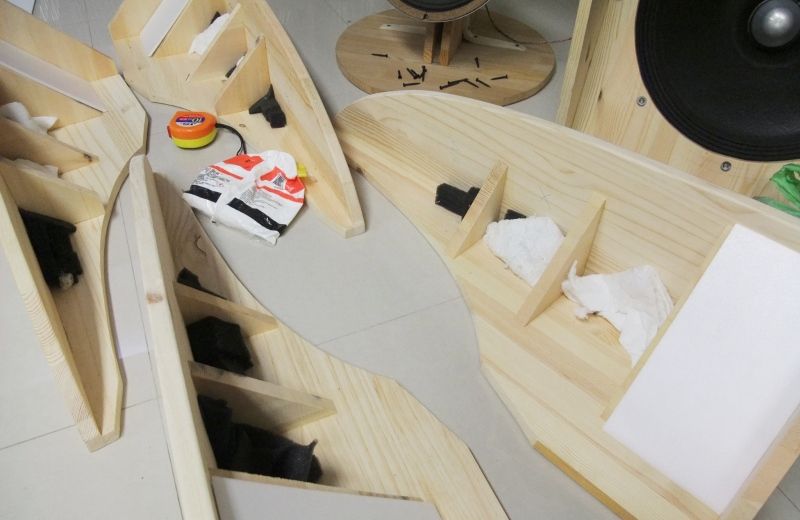
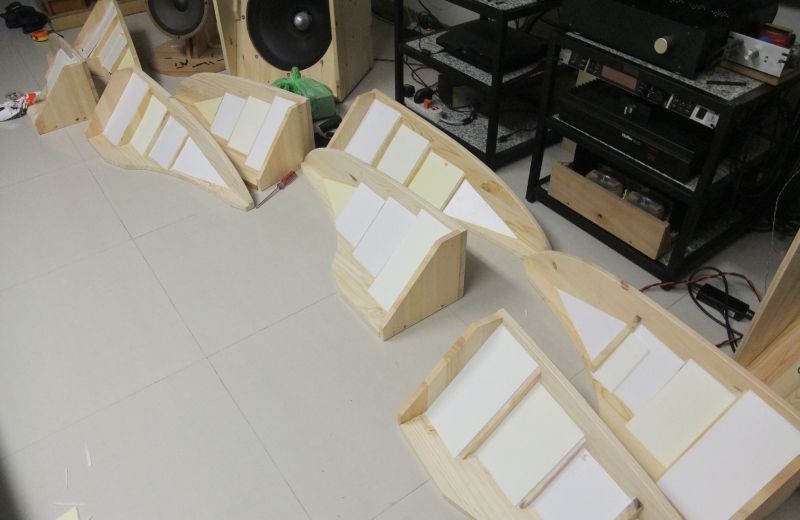
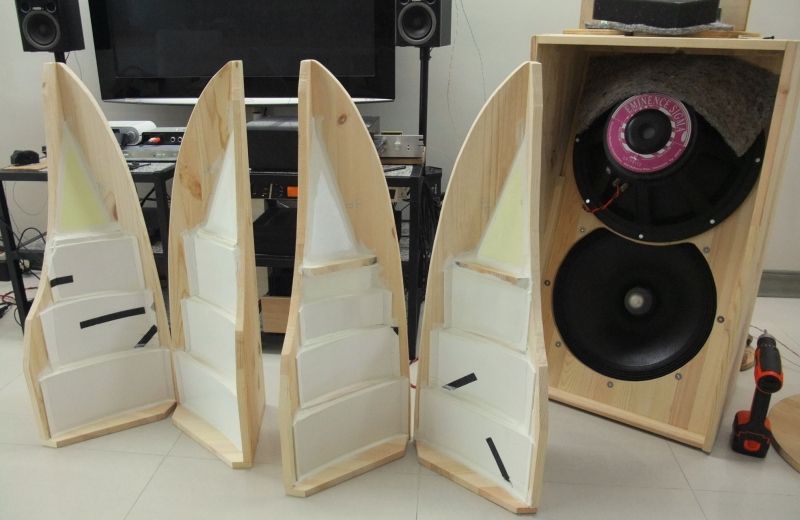
I drop the idea of expanding PU foam and take these leftover materials first. But it's so time consuming. And it hurts my back working on floor.
I want to reduce the space between drivers and wings by these slant surfaces.
This is taken with only one wing being fitted:
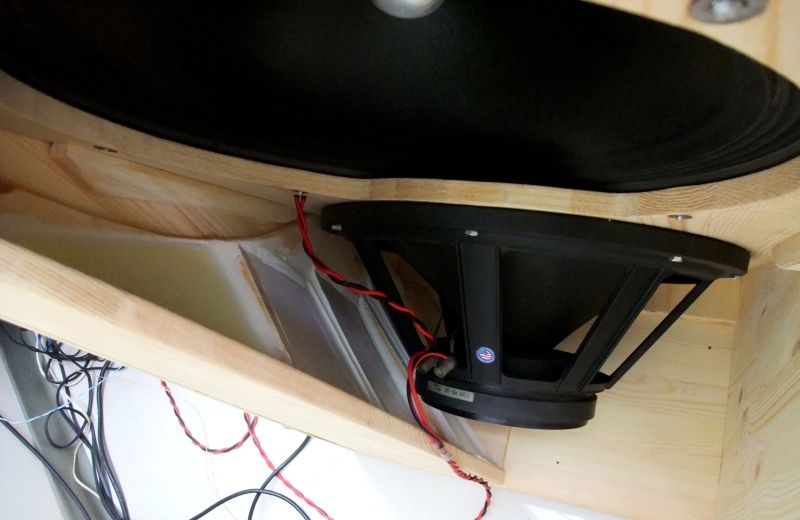
(if with both, I can't take the shot. Not enough space and light.)
To my surprise, again, the reduced space of the cavity doesn't affect much to the mid (higher range of this thing). Some resonances seem reduced, but barely detectable, I'm not quite sure yet.
It turns out the obvious improvement is in the lower bass. I feel it gets enhancement and plays more effortlessly. Maybe the reduced space loads the drivers more. (The fs is slightly dropped, from 16Hz to 15Hz.)
By the experience up to now, it seems the narrow part of aperture affects the lower range more than the high. So, maybe it's worth to try the asymmetric opening suggested in the earlier post, if anyone follows this. (who, me? let me catch my breath...)
At the time I tested them, the sealant wasn't completely dry and hardened yet. So I couldn't turn it up enough to reveal the full potential. Then I had to re-adjust the XO etc., many things were waiting.
For the top, I swapped the Jordan Flagon with 7" Focal mid:
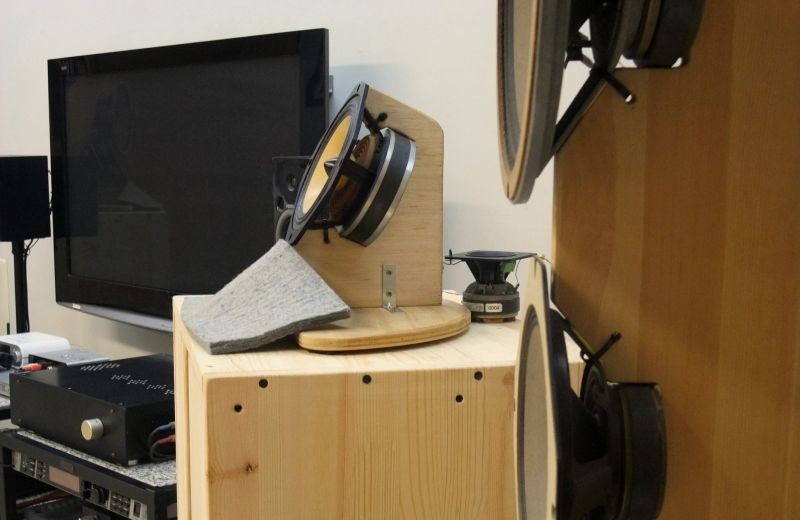
I mount it by my old trick - using a single board as the spine to support the magnet and rear side of frame. (and you can see the upfiring tweeter behind the mid)
A 20 uF cap is in series with it. That's a 6dB/oct slope beginning at 1kHz or so. In this range, no baffle is needed. And, helped by the powerful magnet and light cone, it's capable to play up to 15kHz.
This unit is tilted up by 24 degree. By this angle, its axis (the most powerful lobe) is aiming at the point on ceiling right above my head of listening position. So the reflections from my back would be largely reduced by multiple bounces and long paths. The floor reflection is also reduced, as it's largely off-axis seen by the floor. Also, for off-center listening, it would be more even. I borrow (steal) the idea from Gradient.
The whole thing:
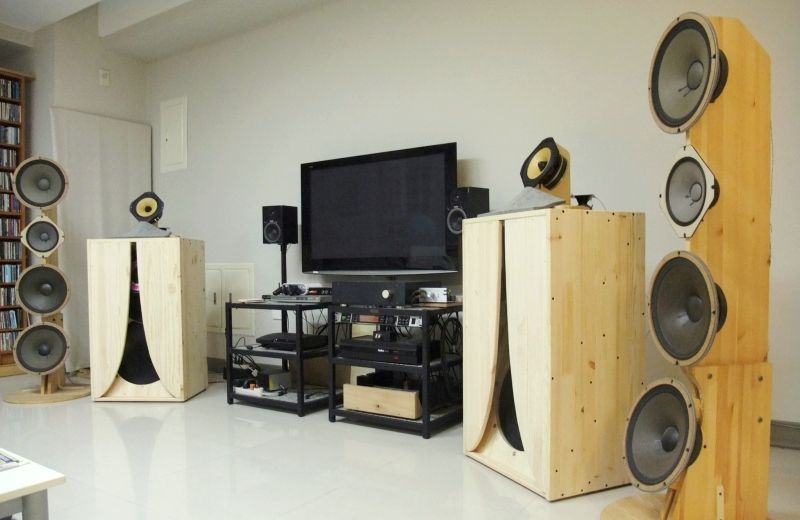
It's funny that the Focal mid looks so tiny in the system, but it's the loudest. Compared to the previous Jordan, the level on amp has to be turned down a lot.
More dynamic and lively sound aside, the best thing is now the whole system is dipole (except the very top of the spectrum). This makes the in room response more even, with stable tonal balance everywhere in the room. It's also what I'm used to. (Jordan Flagon itself is a decent and cute little speaker, just not for here.)
Two naked dipole arrays are playing ambio channels (R-L / L-R) of Hafler circuit by another amp. And there's another central tweeter behind the TV which is also upfiring not visible in the photo... (So it's actually a 4.1-ch system with 17 drivers and 6-ch of amps...)
Oops, it seems too crowded for the 'fullrange' forum.
I'd make some noise.
Forgot to mention, on the day I finished the cabinet with wings, my wife said, "it looks like a (giant) cicada ! "
Yeah, she's right.

I can't decide which is better, Karlcada or Cicalson ?
(They have one thing in common -- loud. It's getting hot summer here, they are screaming out there, right now.)
Say, I've done the following during the last weekend:
Sealing the cavities formed by those triangle bracings, with a little damping material inside, and double-wall (5mm PS foam board and 3mm foamcore) :



I drop the idea of expanding PU foam and take these leftover materials first. But it's so time consuming. And it hurts my back working on floor.
I want to reduce the space between drivers and wings by these slant surfaces.
This is taken with only one wing being fitted:

(if with both, I can't take the shot. Not enough space and light.)
To my surprise, again, the reduced space of the cavity doesn't affect much to the mid (higher range of this thing). Some resonances seem reduced, but barely detectable, I'm not quite sure yet.
It turns out the obvious improvement is in the lower bass. I feel it gets enhancement and plays more effortlessly. Maybe the reduced space loads the drivers more. (The fs is slightly dropped, from 16Hz to 15Hz.)
By the experience up to now, it seems the narrow part of aperture affects the lower range more than the high. So, maybe it's worth to try the asymmetric opening suggested in the earlier post, if anyone follows this. (who, me? let me catch my breath...)
At the time I tested them, the sealant wasn't completely dry and hardened yet. So I couldn't turn it up enough to reveal the full potential. Then I had to re-adjust the XO etc., many things were waiting.
For the top, I swapped the Jordan Flagon with 7" Focal mid:

I mount it by my old trick - using a single board as the spine to support the magnet and rear side of frame. (and you can see the upfiring tweeter behind the mid)
A 20 uF cap is in series with it. That's a 6dB/oct slope beginning at 1kHz or so. In this range, no baffle is needed. And, helped by the powerful magnet and light cone, it's capable to play up to 15kHz.
This unit is tilted up by 24 degree. By this angle, its axis (the most powerful lobe) is aiming at the point on ceiling right above my head of listening position. So the reflections from my back would be largely reduced by multiple bounces and long paths. The floor reflection is also reduced, as it's largely off-axis seen by the floor. Also, for off-center listening, it would be more even. I borrow (steal) the idea from Gradient.
The whole thing:

It's funny that the Focal mid looks so tiny in the system, but it's the loudest. Compared to the previous Jordan, the level on amp has to be turned down a lot.
More dynamic and lively sound aside, the best thing is now the whole system is dipole (except the very top of the spectrum). This makes the in room response more even, with stable tonal balance everywhere in the room. It's also what I'm used to. (Jordan Flagon itself is a decent and cute little speaker, just not for here.)
Two naked dipole arrays are playing ambio channels (R-L / L-R) of Hafler circuit by another amp. And there's another central tweeter behind the TV which is also upfiring not visible in the photo... (So it's actually a 4.1-ch system with 17 drivers and 6-ch of amps...)
Oops, it seems too crowded for the 'fullrange' forum.
Last edited:
CicKazBa 
Hopefully, they sound better than the annoying buzz of a cicada. Those had a hatch a year ago where I am - huge bugs with massive red eyes.
The foam filler looks very nice. It may not sound a lot different but I suspect it should clean up your response smoothness. There should be fewer flat edges for resonant cancellations in the mids.
One thing to try is simply tape a piece of foam core to block to top 6in to 12in of the top slot and see how the bass changes.
Looking good. I like the Focal driver in dipole. You can buy bare Focal drivers? I thought they only use them for their speakers.
Hopefully, they sound better than the annoying buzz of a cicada. Those had a hatch a year ago where I am - huge bugs with massive red eyes.
The foam filler looks very nice. It may not sound a lot different but I suspect it should clean up your response smoothness. There should be fewer flat edges for resonant cancellations in the mids.
One thing to try is simply tape a piece of foam core to block to top 6in to 12in of the top slot and see how the bass changes.
Looking good. I like the Focal driver in dipole. You can buy bare Focal drivers? I thought they only use them for their speakers.
Haha, it does look like a cicada. We don't have them on the west coast, but I've heard about them.
I dare you to make a giant paper mache cicada head and put it on top. See if your wife likes that.

You could buy Focal drivers for DIY until a few (10?) years ago or so. I built my first fully from scratch speakers with them. Dynaudio used to sell to DIY market too, back in the 90's.
I dare you to make a giant paper mache cicada head and put it on top. See if your wife likes that.
Looking good. I like the Focal driver in dipole. You can buy bare Focal drivers? I thought they only use them for their speakers.
You could buy Focal drivers for DIY until a few (10?) years ago or so. I built my first fully from scratch speakers with them. Dynaudio used to sell to DIY market too, back in the 90's.
Ah, so many things... I'll keep doing experiments in the cavity, until I'm satisfied (or completely exhausted).
I also have to 'clean up' some minor problems in the signal chain and amps, too. Testing time is very limited during the weekday, I don't have the chance to crank it up, yet.
The Focal was bought in '95 (and could be the best driver I've owned). Wow, time flies.
I also have to 'clean up' some minor problems in the signal chain and amps, too. Testing time is very limited during the weekday, I don't have the chance to crank it up, yet.
The Focal was bought in '95 (and could be the best driver I've owned). Wow, time flies.
I don't either but that looks like a picture of Jeff Goldblum (the Fly) about to be eaten by a spider. What does Monsanto have to do with it?
Maybe he is talking about how scary the cicada's face looks? They are actually friendly harmless bugs. Big and grotesque but harmless.
Now back to speakers.
CLS, when you play it - is there a powerful jet of air squirting through the narrow portion of the aperture - and is the wind noise an issue? I bet it's pretty powerful but quiet - something about the Karlson shape vs a regular duct. Keeps much quieter for how fast air moves through there.
Maybe he is talking about how scary the cicada's face looks? They are actually friendly harmless bugs. Big and grotesque but harmless.
Now back to speakers.
CLS, when you play it - is there a powerful jet of air squirting through the narrow portion of the aperture - and is the wind noise an issue? I bet it's pretty powerful but quiet - something about the Karlson shape vs a regular duct. Keeps much quieter for how fast air moves through there.
No wind noise. Near the slit, the pumping of LF soundwave is obvious, but I don't detect any noise. The edges of wings are rounded a bit, with about 2-3 mm radius, not shown in the photo. For such frequency, maybe it doesn't matter. Just nicer to touch and for peace of mind.
And, in fact, the feel of the impact is better perceived from a distance, where a wider range of frequency can be heard as a whole. It's all bass in closely front of the slit, similar to the port of a vented box.
Tested more these days, the filled cavity indeed reduces resonances, I can remove some of the notch filters, but not all. I'll keep trying. It seems more damping is needed. Or, maybe I'll have to cut the aperture larger, argh~
I didn't mention in the previous post that I also made this in the last weekend.
Make a guess
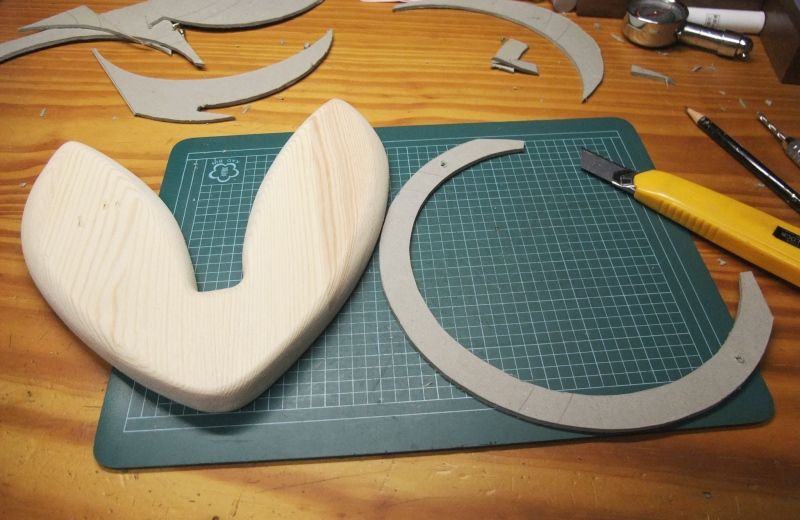
And, in fact, the feel of the impact is better perceived from a distance, where a wider range of frequency can be heard as a whole. It's all bass in closely front of the slit, similar to the port of a vented box.
Tested more these days, the filled cavity indeed reduces resonances, I can remove some of the notch filters, but not all. I'll keep trying. It seems more damping is needed. Or, maybe I'll have to cut the aperture larger, argh~
I didn't mention in the previous post that I also made this in the last weekend.
Make a guess

- Home
- Loudspeakers
- Full Range
- Rockin' the KaZba Dipole (K aperture Z-baffle Dipole)
